Wed, 06 Aug 2014 . Last updated Fri, 13 Mar 2015 16:32
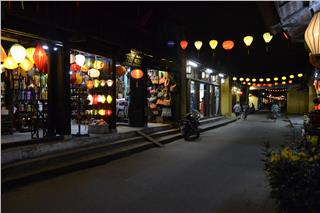
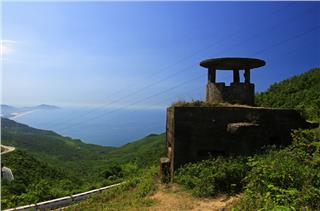
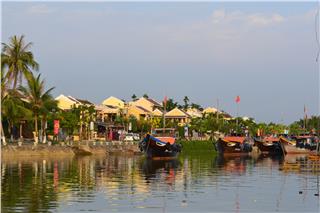
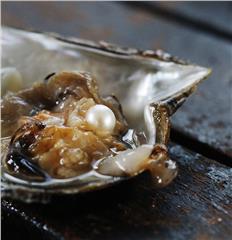
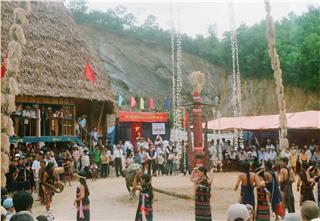
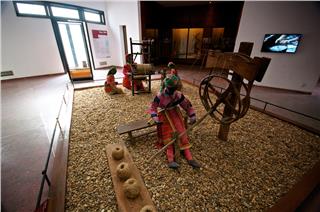
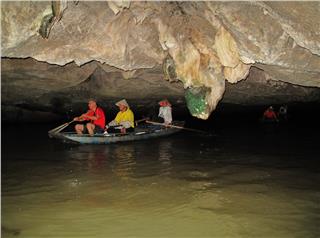
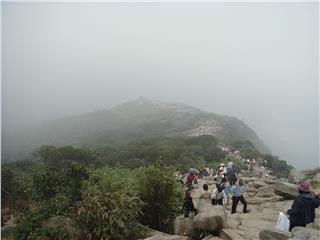
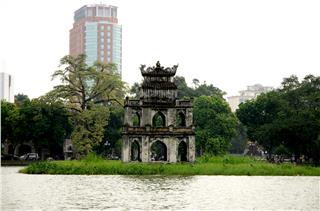
An ancient pagoda on the Earth
Totters on the back of the mountain
White gratefruit flowers blossom in front of the pagoda
An apricot tree stands on the mountain slope.
Among the spectacular beauties of Yen Tu, the harmonious combination among a chain of pagodas, temples and towers with a picturesque setting, there is a pagoda that looks plain but houses a treasure of historical values. Its folk name is “Ban Mai” and its official name is “Ban Thien Tu” or Mot Mai pagoda. In the program “Cultural Heritage” today, we are going to visit the special pagoda, one of the tourist attractions in Vietnam.
Yen Tu also known as Bach Van Son, is a 1068 high mountain covered with white clouds around the year. The pagoda is located in Dong Trieu range, Thuong Yen Cong commune, Uong Bi city, Quang Ninh province. According to the legend, a hermit named An Ky Sinh came here to practice and the he metamorphosed into a stone statue. The local people called him “An Tu” and the mountain where he practiced his religious life is An Tu Mountain or Yen Tu. In the 13th century, after the victory over Mongol invaders, King Tran Nhan Tong ceded the throne to his son and chose this place to practice Buddhism and later founded Truc Lam Zen. Since then, Yen Tu became a famous Buddhist center across the country. The stone “To” (ancestor) Stupa has 6 floors and is the most visible tower in Yen Tu. In the center is Hue Quang stupa, also called Giac Hoang tower. There is a stone statue inside the stupa and a stone incense stick in front of it. Four wall sides around the tower were built by the bricks of Tran dynasty. Each stupa houses the remains of a monk who practiced there.
The Yen Tu architectural complex includes Hoa Yen pagoda and surrounding pagodas. It was named “Van Yen” during the Tran dynasty. After that, it was renamed “Hoa Yen” by King Le Thanh Tong during the reign period of Hong Duc. King Tran Nhan Tong became the first founder with the Buddhist title Dieu Ngu Giac Hoang Tran Nhan Tong. He had hundreds of small and large buildings erected on this high and rugged mountain for practicing and spreading Buddhist teachings. It became the largest monastery of Dai Viet. Perhaps, meditation is a familiar practice to everyone. Buddhist meditation is somewhat different in a different schools including Indian meditation, Japanese meditation, Chinese zen, Vietnamese zen or Truc Lam Yen Tu Buddhist Zen. Therefore, the introduction of meditation into a country was based on practice and customs of people living in that country in order to guide practitioners to the true nature. That explains why there are different schools of meditation in India, Japan, China and Vietnam. Based on the spirit of Buddhism and the customs of Vietnamese people, King Tran Nhan Tong created the sect of Vietnamese Zen – Truc Lam Yen Tu Buddhist Zen sect.
The pagodas, temples, towers, steles, statues in Yen Tu are valuable historical relics associated with the name and the Buddhist life of King - Monk Tran Nhan Tong and generations of Buddhist monks who practiced here. Linh Son Yen Tu has become great pride if Vietnamese people and won the admiration of foreign visitors.
In my research into many pagodas, I found that Quang Ninh is like a culture in the flow of Vietnamese culture. Especially, during the archaeological work, since 1954, we have studied about 1000 relics of the prehistory. Besides civilizations of Son Vi, Bac Son and Hoa Binh, Halong is also included in that flow. During our survey in Quang Ninh, I found out numerous sites of great archaeological interest. Vietnamese people believe that all creatures have soul and there are gods and saints everywhere, especially on the mountainous areas that are seen as bridges linking Heaven, Earth and Human. Ancient traces of Yen Tu are clearly visible in this land. Now, visitors have different ways to shorten their journey to Dong pagoda but a lot of visitors still climb up thousands of sloping rock steps to the highest pagoda on the Yen Tu peak. This is a way for them to express their sincerity towards the Ancestors.
Dong pagoda called “Thien Truc” was built in the later Le dynasty. The pagoda overlooks the entire Northeast region, Bach Dang River, Halong Bay looking picturesque as an ink wash painting. Standing in the place where the Heaven and Earth meet, we would feel like touching the blue sky and white clouds of the fairy land. It would be incomplete if you do not visit Yen Tu yet during your practice of a religious life. In the chain of towers and pagodas of Yen Tu, we cannot but mention “Ban Thien Tu” (Mot Mai) pagoda. It is located on a small mountain slope 500 meters away from Hoa Yen pagoda to the left. Leaning against the mountain halfway to the peak, the pagoda has a half hidden that has half of the roof that is why people call it “Ban Mai” (Half Roof) or “Mot Mai” (Single Roof).
In Yen Tu, the pagoda is normally called Mot Mai by local people. It is a special pagoda in the Yen Tu relic site. This was the refuge of King-Monk Tran Nhan Tong after he became a monk. After that, he moved to the center of Hoa Yen pagoda for practicing Buddhist teachings. It is more interesting to put the “Mot Mai” pagoda into the system single-roof pagodas found across the country, associated with stories about the formation and messages passed down by previous generations. We can see the pagoda with one roof like “Mot Mai” or called “Ban Thien Tu” pagoda across the country, from Halong to Bac Son, Lang Son, Ninh Binh, Thanh Hoa, Nghe An. Ancient Vietnamese people used to live in caves. This was a place for daily, funeral and working activities. Funeral places are holy places, as people paid special respect to the human souls. Due to this reason, in Yen Tu, when the patriarchs and monks died, people worshipped then into a most solemn way. Previously, there was only a small temple here called “Ly Tran”. The temple stood in quiet and heavenly scenery, so it was called “Ly Tran”. The King Tran often came here to read books and wrote Buddhist teachings. The texts and bibliographies were stored here. After his death, people built this pagoda.
Unlike other pagoda, this single-roof pagoda is like a pagoda in the grotto. The whole pagoda is made of wood. The inner half leans against the wall of the grotto, while the outer half is covered by a wooden roof. The pagoda is 1.96 meters long and 1.7 meters deep. The space of pagoda is narrow; in the outer is domed cave. There is a stalactite in the grotto from which water falls down in drops. Ancient people called it mother’s milk. The chief monk takes this pure water to wash fruits and offer to the Buddha. Visitors coming here want to enjoy a sip of this water to get good fortune. As believed by people, water taken from here and Dong pagoda was so holy to offer to the ancestors. For this reason, Buddhist followers come to the pagoda to offer incense and bring some water home. There is a hole on the roof of grotto. Legend has it that it was a small crack through which a stream of rice fell down. The chief monk took the rice to get a full meal. He did this day by day. One year, there was severe drought and prices of rice rose sharply. He intended to make the hole bigger to get much more rice. Right when he just did it, sand fell down. He quickly ran away. Fortunately, a stone sealed the hole. Neither sand nor rice flowed down any longer. That is the ancient story but it brings profound humanistic meaning.
There are legends about the milk of mother and rice in the Mot Mai pagoda. This is an expression of the Cult of fecundity in Vietnam. It also expresses aspirations of prosperity and unfailing rice. Rice was just for use of good people, not greedy people. That is a great cultural value. It displays the desire for longevity, prosperity of Vietnamese people. The temple has 3 compartments and 3 altars arranged from the outside inward, including the Ancestral altar and three steles written with characters recording the events.
The “three refugees” altar includes three atstues of Tam The, 1 Shakyamuni Buddha statue, 1 Buddha statue and 1 Mother Goddess statue. The rear altar consists of a stone stele dating back to the reign of Bao Dai King – 1936 and some other worshipping objects. Due to the narrow space, the altars must be in proportion to the size of pagoda. All the statues and worshipping objects were made of white marble with smaller sizes than those in other pagodas, dating back to the late Le Dynasty (early Nguyen Dynasty). The statues are sophisticated sculptures with original aesthetic values.
The pagoda houses the most ancient statues in Yen Tu, which have great values in sculpture, culture of “Ban Thien” or “Mot Mai” pagoda. There are inscriptions on the rock walls or stone steles that provide valuable information on the history and the social situation from Le Dynasty to Nguyen Dynasty, “Ban Thien” pagoda’s history is of great meaning. Additionally, it reflects burning aspirations of Vietnamese people. Vietnamese Buddhism lies in great harmony with folk beliefs including the cult of fecundity.
The sacred Yen Tu Mountain is the place where the Heaven and the Earth meet. It is seen as a holy place where each tree, stream, grotto and tower is associated with legends and mysterious stories. There are mysterious stories around “Ban Thien Tu” pagoda, too.
Quang Ninh has developed a comprehensive plan to restore the beauty of Yen Tu. This was approved by the government. Apart from large-scale constructions, we will repair and restore the Yen Tu pagoda and associated structures to preserve their tangible and intangible cultural values.
Millions of visitors come to Yen each year to find peace of mind and practice reconciliation, tolerance and mercy. Everybody whishes to burn an incense stick at “Giai Oan” pagoda, Trinh pagoda, Mot Mai pagoda, touch the dune of rice and the mother’s milk breast to pray for good health. These are simple but sacred things in life that reveals the philosophy of Truc Lam Yen Tu Zen.
The chain of Mot Mai, Hoa Yen, Dong …pagodas along with the famous temples and towers in Yen Tu has together formed a valuable cultural relic site. This is a place where Zen masters spent their whole life practicing religion and became Holy Saints. Tranquility and solemnity reining this place help people clear off the dust of life.
The spectacular “Mot Mai” pagoda leans against the mountain halfway to the peak, its architectural and historical values make it a major part of the chain of local pagodas and towers associated with Dai Viet Buddhism and Truc Lam Zen sect.
Source: VTC10 - vtc.com.vn

 Đặt vé máy bay cho người Việt?
Bấm vào đây
Đặt vé máy bay cho người Việt?
Bấm vào đây
Our service uses cookies for technical, analytical and marketing purposes. See our Cookie và Privacy policies for more information. If you agree to this, just keep browsing.


